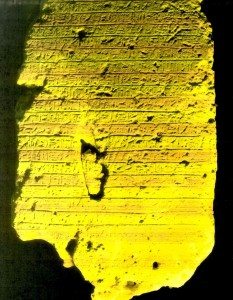
Stela found at Taposiris Magna, inscribed in Hierglyphic and Demotic side by side.
The SCA Archaeological Mission in collaboration with the Catholic University of Santo Domingo (Dominican Republic) working at the Taposiris Magna site succeeded in discovering a limestone stele inscribed with Hieroglyphic and Demotic inscriptions.
The Minister of Antiquities, Dr. Eldamaty stated that the discovered stele contains 20 Hieroglyphic lines with royal cartouches of king “Ptolomy V” whom the stele was inscribed during the seventh year of his reign. Cartouches of Ptolomy’s wife and sister, Queen “Cleopatra I”, his father, King “Ptolomy IV” and his wife “Arsinoe III” also appear.
The Demotic inscriptions that lie at the bottom of the stele consist of five lines of a text that seem to be a translation and a copy of the previous Hieroglyphic lines. Eldamaty added that the stele is a 105 cm. length, 65 cm. width and 18 cm. thick.
A Significant Discovery
The Antiquities Minister stressed that the importance of this discovery lies in the different scripts forming it, resembling the Rosetta Stone which was inscribed in the ninth year of king “Ptolomy V” ‘s reign which means two years after this Stele was inscribed.

Tetradrachm of Ptolemy V
The stele is an excat copy of the stele of Philae Temple – Aswan which dates back also to king “Ptolomy V” that reflects the king’s offering a huge area of Nubia to the goddess Isis and her priests.
On the other hand, Chief of the Dominican Egyptian Mission, Dr. Kathleen Martinez added that the mission has been working for six years at Taposiris Magna Site and made a lot of important discoveries concerning the history of Alexandria in general. Some of the major discoveries are tombs of Nobles and a number of statues of the goddess Isis in addition to many bronze coins belonging to Queen “Cleopatra”.
Supreme Council for Antiquities (Egypt), via Past Preservers
